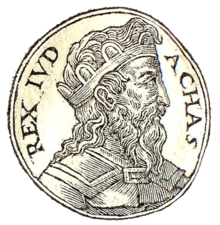Ahaz
| Ahaz | |
|---|---|
| King of Judah | |

Ahaz from Guillaume Rouillé's Promptuarii Iconum Insigniorum, 1553
|
|
| Reign | 735 - 715 BC |
| Predecessor | Jotham of Judah |
| Successor | Hezekiah |
| House | House of David |
Ahaz (Hebrew: אָחָז, ʼĀḥāz; "has held"; Greek: Ἄχαζ Akhaz; Latin: Achaz; an abbreviation of Jehoahaz, "Yahweh has held" (Akkadian: Ia-ú-ḫa-zi)) was king of Judah, and the son and successor of Jotham. Ahaz was 20 when he became king of Judah and reigned for 16 years. Ahaz is portrayed as an evil king in the Book of Kings (2 Kings 16:2)
Edwin R. Thiele concluded that Ahaz was coregent with Jotham from 736/735 BC, and that his sole reign began in 732/731 and ended in 716/715 BC.William F. Albright has dated his reign to 744 – 728 BC.
The Gospel of Matthew lists Ahaz of Judah in the genealogy of Jesus. He is also mentioned in Isaiah according to the King James Version.
Ahaz's reign commenced at the age of 20, in the 17th year of the reign of Pekah of Israel. It is described in 2 Kings 16; Isaiah 7-9; and 2 Chronicles 28.
Immediately upon his accession Ahaz had to meet a coalition formed by northern Israel, under Pekah, and Damascus (Syria), under Rezin. These kings wished to compel him to join them in opposing the Assyrians, who were arming a force against the Northern Kingdom under Tiglath-Pileser III. (Pul). To protect himself Ahaz called in the aid of the Assyrians. Tiglath-Pileser sacked Damascus and annexed Aram. According to 2 Kings 16:9, the population of Aram was deported and Rezin executed. Tiglath-Pileser then attacked Israel and "took Ijon, Abel Beth Maacah, Janoah, Kedesh and Hazor. He took Gilead and Galilee, including all the land of Naphtali, and deported the people to Assyria." Tiglath-Pileser also records this act in one of his inscriptions.
...
Wikipedia
